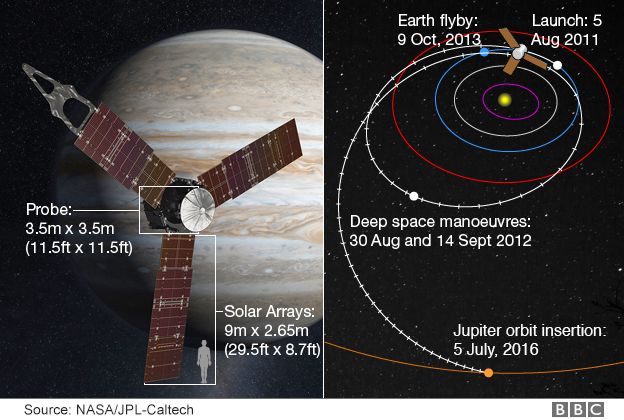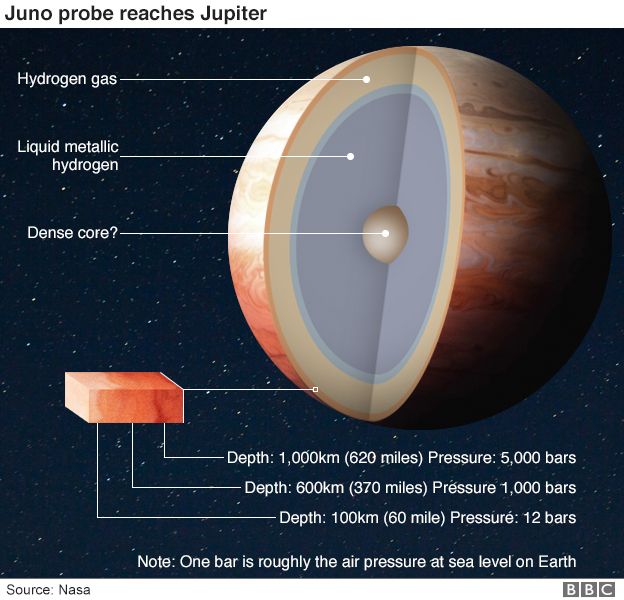Juno fires it’s main engine for 35 minutes burn to enter Jupiter’s orbit. Finally Juno is orbiting the giant planet Jupiter after 5 long years. Earlier Nasa has predicted that its Juno probe is on course to go into orbit around the Planet Jupiter.
Success! Engine burn complete. #Juno is now orbiting #Jupiter, poised to unlock the planet’s secrets. https://t.co/YFsOJ9YYb5
— NASA (@NASA) July 5, 2016
The satellite is described as healthy and ready for what scientists concede will be a risky manoeuvre. Juno has to execute a precise rocket firing to slow itself sufficiently to get captured by the giant world’s gravity.
Fly with @NASAJuno in this 360° experience! Move your mouse or phone to see the entire view: https://t.co/rzjg2HZa1v pic.twitter.com/GF06df3fDy
— NASA (@NASA) July 4, 2016
If it succeeds, researchers should get their best ever view of what lies beneath Jupiter’s stormy clouds.
Here’s the last pic @NASAJuno took prior to shutting off its instruments 5 days ago https://t.co/eW0o09yEgh #Jupiter pic.twitter.com/xD9R9CxRn0
— NASA (@NASA) July 4, 2016
The 35-minute orbit insertion burn – timed to to start at 03:18 GMT (04:18 BST) on Tuesday – is sure to jangle the nerves of everyone here in mission control at the Jet Propulsion Laboratory (JPL) in California.
After a 5-year trek, I’m 1 week from #Jupiter. See the trailer for my #July4th orbit arrival https://t.co/nU3cvipV90 pic.twitter.com/lcs71gEfUJ
— NASA’s Juno Mission (@NASAJuno) June 27, 2016
If the engine fails to fire at the right time or for an insufficient period, this $1.1bn (£800m) venture will simply fly straight past Jupiter and into the oblivion of deep space.
Juno will not have its main dish pointed at Earth during the braking procedure, so the mission team will have to follow events via a series of simple tones sent back through the probe’s low-gain antenna.
Accoprding to the report Rick Nybakken, Juno’s project manager, said the probe had to thread itself on to a very accurate trajectory to achieve its goal. e also told the media:
“What we’re targeting is a space that’s tens of km wide. We’re going to hit that within 1.2 seconds after a journey of [2.8 billion km]. That tells you just how good our navigation team is,” he told reporters.
“We need to get into orbit tonight and I’m very confident we will.”
No solar-powered spacecraft has worked so far from the Sun, hence its huge panels.

The scientists must sit on their hands, though. The event is so far away, radio messages take 48 minutes to cross the vastness of space. Juno has to do everything on its own.
They will also gain new insights on the famous Great Red Spot – the colossal storm that has raged on Jupiter for hundreds of years. Juno will tell us how deep its roots go.

A key quest is to determine the abundance of water in the atmosphere – an indicator of how much oxygen was present in Jupiter’s region of the Solar System when it formed, and perhaps a tell-tale of any migration it may have made from its original formation location.

Nasa plans to run the mission through to February 2018. Juno will be commanded to end operations by ditching itself in the atmosphere of the planet.
This ensures there is no possibility of the probe crashing into and contaminating Jupiter’s large moons, at least one of which, Europa, is considered to have the potential to host microbial life.
Also Read: Modi cabinet rejig today
(Courtesy: BBC, NASA)
